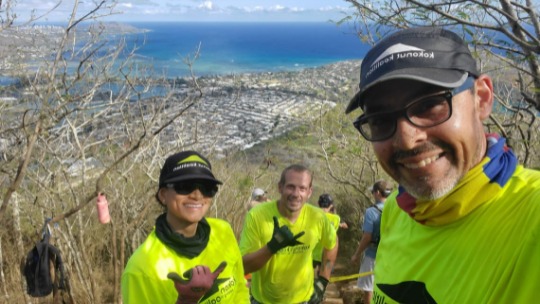People hike the Koko Crater Railway Trail for lots of reasons. For some, it’s their workout. Some love the stunning 360-degree view. Others hike for more personal reasons ― they hiked it while they were recovering from cancer, they’re delivering a prayer for a deceased family member who loved the trail, or they’re one of the firefighters who hike it every 9/11.
Koko Crater was the first trail Dave Nixon, president of Kokonut Koalition, hiked when he arrived in Hawaii. It wasn’t his usual walk in the woods, but he found the climb challenging and rewarding. He returned over the years to see progressive decay and neglect.

Dave Nixon
“For me, it just seemed a terrible shame,” says Nixon. “I had climbed it and it is beautiful. It appeared to me that we were on a path to me not being able to ever do it again and my kids never being able to do it.”
That’s what inspired him to respond to a sign he saw on the trail from Kokonut Koalition, a small group of Koko Crater regulars who were raising money to repair the trail. Since then, he’s helped the organization become a nonprofit, secure permits, and coordinate the repair of more than 700 of the trail’s 1,048 steps.
The restoration became the largest community project in the history of Hawaii.

All in a day’s work
Anyone who’s hiked Koko Crater in recent years knows the repairs were sorely needed. Many steps were rotted through and others were hanging in midair above the eroded mountainside. Some regulars took to making piecemeal repairs to save the trail they love.
“They would buy some 2x4s and take them up there and try to screw them in and build a little step,” says Nixon. “It was just a total, ramshackle mess because building something that can withstand 500,000 people a year is not straightforward.”

Kokonut Koallition was determined to do things the right way so they’d withstand years of future use. When Nixon joined in 2018, the group was fundraising and planning. Eventually, they gained the support of a city council member who was a Koko Crater regular. The city agreed to provide some funding if they did all the work themselves.

In December 2020, they started testing their method of manually carrying material up the mountain. It was a success. From then on, they worked every day reinforcing the steps with rail clips every two to three feet and installing erosion-resistant boxes filled with gravel.

“I think we all have the same feeling about it, which is a real sense of pride and accomplishment. You don't often get a chance to be involved in something like this except maybe once in a lifetime,” says Nixon. “It was a remarkable experience. It was never a drag. It was hard work but a tremendously enjoyable experience every week that kept us coming back.”

Nixon says about 100 people a day carried lumber, gravel, and equipment up to those doing the repairs. They worked with safety precautions throughout the COVID-19 pandemic while thousands of people hiked around them. Residents and regulars pitched in, but so did tourists. In fact, Nixon estimates about a quarter of those volunteering on any given Saturday were visitors and many volunteers were hiking Koko Crater for the first time.
On Oct. 16, Kokonut Koalition installed the final Koko Crater step. “There is a powerful feeling of community now because we did the work together,” says Nixon. “A large number of people chipped in to help and we saved it.”

Kokonut Koalition still needs help boxing in the Koko Crater stairs. Volunteer and learn more about their restoration project.




